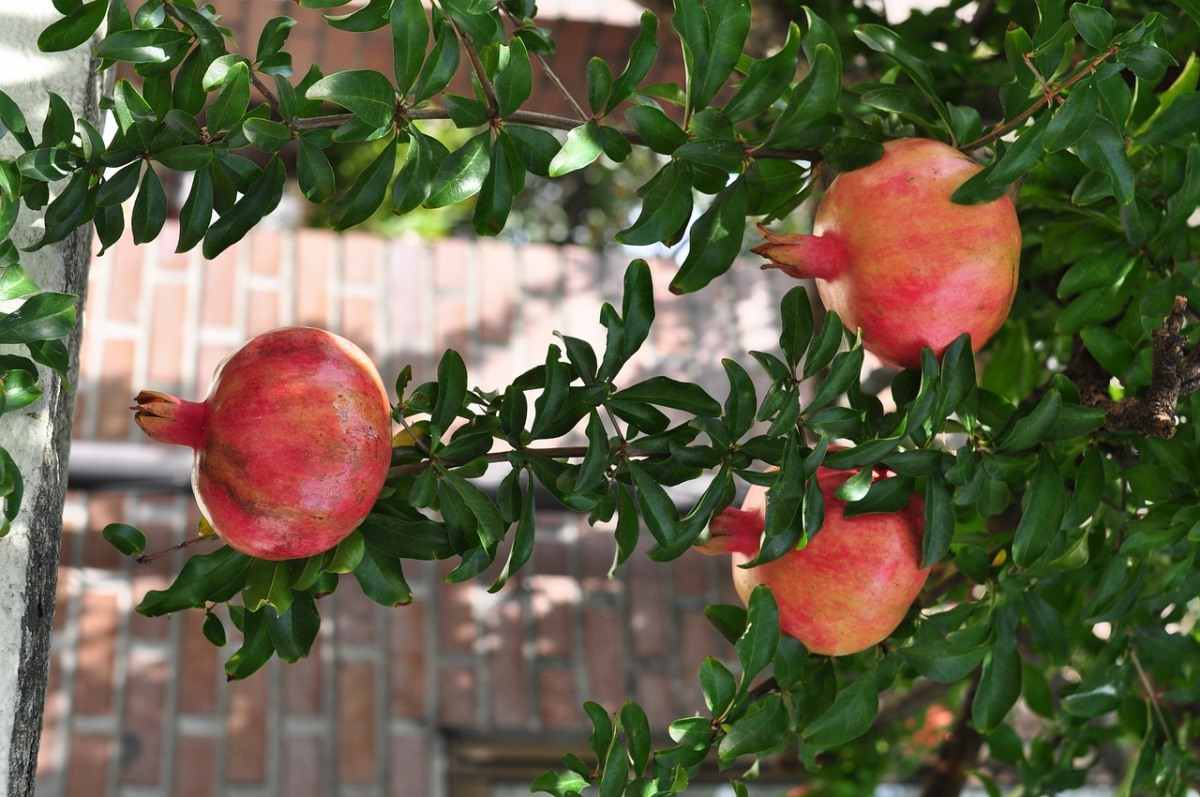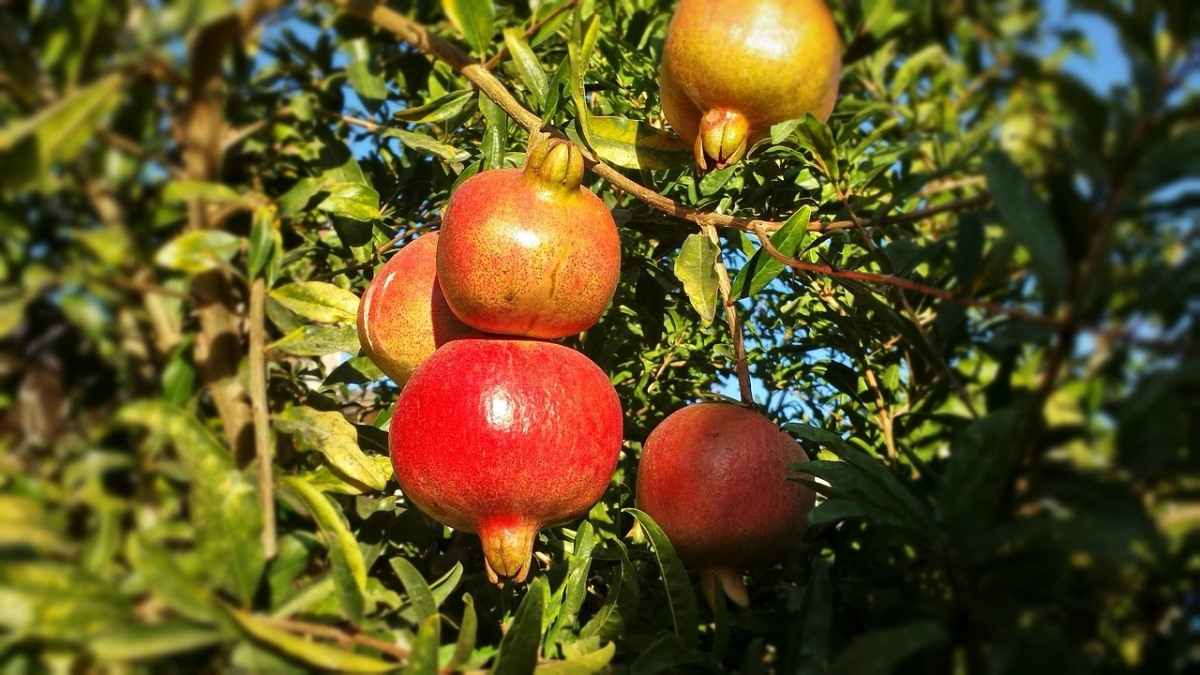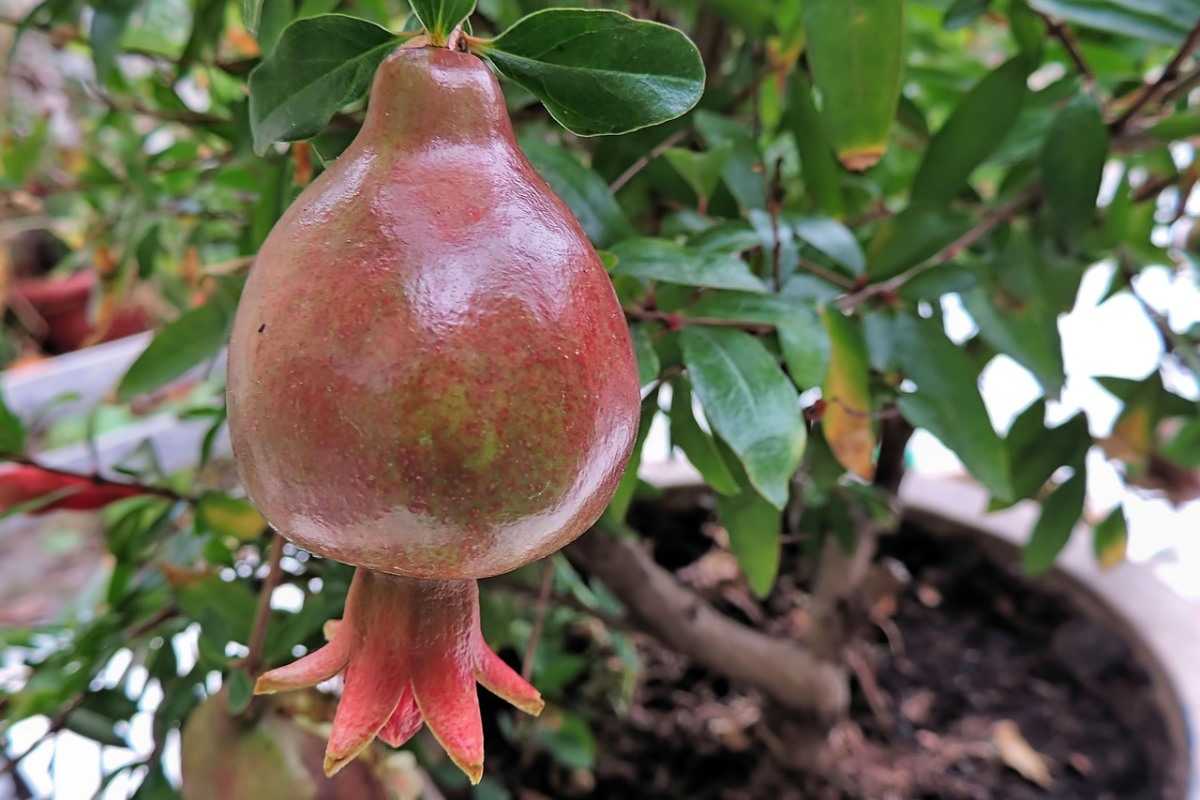Pomegranate Growing Tips, Techniques, Ideas, and Secrets
Hello gardeners, we are here with a new and helpful topic today and the topic is all about pomegranate growing tips, techniques, ideas, and secrets. Do you want to grow a perfect pomegranate tree and do you want to know all the basic tips for growing a pomegranate plant? Well and then you will need to follow this complete article to know all the tips, techniques, ideas, and secrets.
Introduction to Pomegranate
The pomegranate may be a fruit-bearing deciduous shrub within the Lythraceae, subfamily Punicoideae that grows between 5 and 10 m tall. The pomegranate was originally described throughout the complete Mediterranean region.
There are few things more delicious in this world than a juicy pomegranate. The glistening insides of the fruit sparkle like numerous edible rubies. If you’re keen on pomegranate, then try growing your own plant. While the plant is more shrub-like than tree-shaped, you’ll train your pom to require the form of a tree.
A Guide to Pomegranate Growing Tips, Techniques, Ideas, and Secrets

The Overview Table of Pomegranate is Given Below
| Botanical Name | Punica granatum |
| Common Name | Pomegranate and anar |
| Plant Type | Shrub or small tree |
| Size | From 3 ft. dwarf forms and to 30 ft. tall trees |
| Sun Exposure | Full sun |
| Soil Type | Grows in most types and must be well-drained |
| Soil pH | Acidic, neutral, alkaline that is 5.5 to 7 |
Pomegranate Tree Varieties
There are many planters to settle on from, including some that are colder hardy. A number of the favored types include:
- Nana
It is a dwarf form that’s cold-hardy and typically grows to only 4 feet tall.
- Sweet
Produces fruit before some planters and, because the name suggests, features a very sweet flavour and typically provides a prolific harvest.
- Wonderful
The most popular planters grown within the U.S.; produce large, flavourful, red fruits in abundance late within the season.
Basic Caring Tips for Pomegranate Plants

Pomegranates need full sun to survive. Keep an eye fixed on the weather report and if temps threaten to drop below 4°C, then move the plant indoors to a sunny window.
Water the tree deeply about once a week and possibly more often during peak summer months. Fertilize the tree with half a cup or 118 ml of 10-10-10. Spread the fertilizer a top of the soil and a couple of inches or 5 cm far away from the trunk. During the primary two years of the tree’s growth, feed-in November, February, and May, and thereafter fertilize only in November and February.
You need to prune out any crossing branches or shoots to 3 to 5 per branch after the tree’s first year. Prune out any dead or damaged limbs within the late winter. Then prune out suckers to make a more tree-like appearance.
Follow the above tips, and within two years, you’ll have delicious pomegranate fruit of your own that last as long as apples (up to seven months) in cool and dry conditions.
Pomegranate Soil Preparation Tips and Ideas
- Which soil is suitable for pomegranate trees?
Loamy
Good soil: Deep loamy or alluvial, well-drained soil is much recommended for pomegranate cultivation. Soil depth minimum 1.5 meters, pH 6.0-8.0, reach in organic carbon is taken into account to be a perfect soil for pomegranate cultivation.
Choose a soil that drains well. Pomegranate trees aren’t ready to deal with waterlogged soil is also known as “soggy feet”. Instead, they are doing best in well-draining or maybe sandy soil. Better to maintain that slightly acidic soil is best for pomegranates, though they also grow alright in moderately alkaline soil. For the foremost part, pomegranates will adapt to the soil they’re planted in, goodbye because it drains well.
Techniques of Growing a Pomegranate Tree from the Seed
There isn’t much to mention about the way to plant a pomegranate seed since these seeds sprout readily without an excessive amount of help. The seeds should be cleaned of the fleshy aril surrounding them and will be planted in loose soil with a covering layer a few 1/2 inches or 1.5 cm.
Heat needs to be second on your pomegranate seed care list. These seeds will germinate at normal temperature in about 30 to 40 days. Bring the soil temperature up a couple of degrees and you’ll cut this point in half. Try surrounding your plant with foil and then placing it in direct sun until the seedlings sprout.
There is another method that ought to be mentioned when describing the way to plant a pomegranate seed. It’s called the baggie method. Some gardeners swear by this method for growing pomegranate from seeds. Make a filter wet and squeeze out the surplus water. Sprinkle the cleaned seed on one-quarter of the filter. Carefully fold the filter into quarters and then slide it into a sealable bag. Store in a very warm place and then check the bag every few days for germination. Once the pomegranate seeds sprout and then transfer them to a pot.
Use any small container that has good drainage and plant two to 3 seeds per pot. You’ll need to pinch off the weaker seedlings after they’re a couple of weeks old or transplant them to their own pot. That’s it.
Caring Ideas for Pomegranate Tree Saplings
If you would like to understand the way to grow a pomegranate that’s healthy and powerful, the trick is in pomegranate care.
In their natural habitats, the calcareous or chalky, alkaline soil is ideal for planting pomegranate trees, so for you, pomegranate care should begin with the planting medium. The soil or planting media should be slightly alkaline with a pH of up to 7.5. Since most planting mediums are developed to fall within the neutral range, the addition of a really bit of limestone or garden lime to the combination should be sufficient.
Now that you simply skills to grow pomegranate from seed, you ought to remember that your seeds might not grow faithful to the cultivar they came from. Still, your new pomegranate will produce fruit in 1 to 3 years and then zip tastes better than something you’ve got grown yourself.
Secrets for Growing Pomegranate Trees in Containers
In case if you miss this: Lemon Growing Tips, Ideas and Secrets.

Pomegranates thrive in areas of warm, arid conditions. While not all folks reside in such climactic regions, the great news is that growing a pomegranate in a pot is entirely possible. Pomegranate trees in containers can either be grown indoors given sufficient arid provisions or outdoors in a part of the year and then moved indoors if cold snaps are imminent.
Pomegranates are self-pollinating, so you simply need one to line fruit. The relatively hardy and even can bear fruit within the second year.
For outdoor or indoor pomegranate trees grown in containers, you’ll need around a ten gallon or 38 L container one-quarter filled with potting soil. Set the basis ball into the container and start to fill in around the roots with the soil to the highest of the container but not covering the trunk. Water the new tree in well and lightly tamps the soil right down to eliminate any air pockets.
Watering Techniques for Growing Pomegranate Tree
The pomegranate tree is drought tolerant, though irrigation is required for correct fruit production. Water very deeply every two to four weeks during the season once you are establishing new trees.
Be careful, however, to not overwater. Excess water and even soggy conditions can cause a poor harvest. The fruit also will be more susceptible to splitting, increasing the probabilities of problems with pests and fungal diseases.
Water the pom immediately after planting it. Doing this will help to settle the soil that is around the newly planted pomegranate. After the initial watering, then water the plant daily until it begins to grow new leaves. New leaf growth is that the sign that your plant has settled into its new home. Gradually, transition to watering your plant every seven to 10 days.
When the tree is flowering or producing fruit, give the plant an honest, deep watering hebdomadally. If it rains, you do not get to water it quite the maximum amount.
Techniques for Pruning and Maintaining Your Pom
Train the plant into tree form, if desired. While pomegranates are more of a shrub than a tree if left to grow untrained, you’ll trim the plant so that it’s sort of a tree. This is often something that a lot of gardeners do.
Using gardening shears or clippers cut the suckers (the smaller branches that help the plant combat its shrub form) growing at the bottom of the plant so that it takes on more of a tree shape. Do that shortly after the plant has become established.
If you do not care whether your plant is tree-like or not, let it grow naturally.
Remove dead or damaged parts of the plant. You do not need to prune your pomegranate to take care of it, but it’s an honest idea to chop away dead or dying branches within the spring to assist the tree to grow well. You’ll also thin the plant as you see necessary.
If you’re growing the pom during a container, you’ll get to prune and train a touch more heavily, to stay the pom the dimensions and shape you would like it to be.
Pomegranate Winter Care
Dense and bushy deciduous plants, pomegranates can get older to twenty feet or 6 m tall but are often trained as a smaller tree. Pomegranates usually produce their best fruit in regions of cool winters and hot and dry summers. While they’re colder hardy than citrus, similar rules apply and specific efforts should be made for pomegranate trees within the winter.
Pomegranate care in winter means – moving the plant indoors, especially if they grow in a neighbourhood with poor air circulation or heavy soil.
So what steps do you have to take before winter look after pomegranate trees?
The first step in pomegranate winter care is to prune back the tree by about half within the fall, six weeks approximately before the primary potential frost. Use sharp shears and cut just above a group of leaves. Then move the pomegranate inside near a sunny and southern exposure window. Even during the winter months, the pomegranate tree needs a minimum of eight hours of sunlight per day or it’ll become leggy and drop leaves.
- Additional Winter look after Pomegranate Trees
When overwintering pomegranate trees, make certain to take care of temperatures above 15°C therefore the plants don’t go dormant. Position them so that they aren’t in any drafts or near heating vents whose hot, dry air will damage the leaves. Even as with other plants during a dormant or semi-dormant phase, water the pomegranates sparingly during the winter months. Only moisten the soil down an in. or 2.5 cm hebdomadally to 10 days. Doesn’t overwater since pomegranates don’t like wet soil.
Turn the pot once every week to permit all parts of the tree to urge some sun. If you reside during a warmer area and obtain warm, sunny winter days, move the plant outside; just remember to maneuver it back in when temps begin to fall.
Pomegranate trees look after the winter is nearly over once spring is imminent. Begin a traditional watering routine a few months before the last spring frost forecast in your area. Move the pomegranate outside once night-time temps have risen to above 10°C. Place the tree during a partially shaded area to acclimate so it doesn’t enter shock. Throughout the subsequent fortnight, gradually introduce the tree to direct sunlight.
All in all, pomegranates need little or no care while overwintering. Provide them with enough light, water, and heat during this point and you ought to have a thriving, fruit-laden tree mid-summer.
Fertilizing Tips of Pomegranate Tree
Fertilize the pomegranate once it’s established. Ammonium sulphate fertilizer works very well for pomegranates. Sprinkle about ⅓ of a cup of fertilizer 3 times throughout the primary year of growth (February, May, and September are ideal times to try this).
Pests and Diseases Controlling Ideas of Pomegranate Tree
- Cercospora fruit spot
Diseased fruits should be removed and destroyed; infected twigs and branches should be pruned out; applications of appropriate fungicides can help to regulate the disease.
- Heart rots (Blackheart)
No known method of control.
- Aphids (cotton aphids)
Encourage natural enemies. Keep the sector free from crop debris and weeds. Spraying a robust jet of water to dislodge the aphid. If infestation is severe spray suitable insecticide.
- Leaf-footed plant bugs
If the infestation is severe apply suitable insecticide.
- Mealy bug (Grape mealy bug, citrophilus mealy bug, striped mealy bug)
Spraying soap solution reduces the mealy bug population. Encourage natural enemies. If the infestation is severe apply suitable insecticide.
- Omnivorous leaf roller
Keep the sector free from weeds. Remove the infected fruits and burn them. Use pheromone trap to kill adult insects.
- Pomegranate fruit borer (Anar butterfly, common guava blue butterfly)
Remove the damaged fruit and burn them. Grow available resisting varieties. If infestation is severe spray suitable insecticide.
- Citrus Flat mite
Application of sulphur before and after flowering reduces the mite population.
Pomegranate Harvesting Tips
- When to reap Pomegranates?
They’re grown in mild temperate to subtropical climates in regions with cool winters and hot summers. Drought tolerant, the trees prefer a semi-arid climate, planted in deep, acidic loam with good drainage.
Don’t expect to start harvesting pomegranate fruit until 3 to 4 years after planting. Once the trees have reached that age of maturity, the fruit will ripen about 6 to 7 months after flowering – generally making harvest season for pomegranates in September for early ripening varieties and even continues through October for later ripening cultivars.
When harvesting pomegranate fruit, pick when the fruit is fully ripe and crimson since it doesn’t still ripe post-harvest. Begin picking pomegranates when the fruit makes a metallic sound once you tap it together with your finger.
- How to reap Pomegranates?
When you can harvest, cut the fruit from the tree, don’t pull it off. You need to cut the fruit as close as possible to the branch, taking the stem with the fruit.
- Flower Garden Designs and Layouts for Beginners
- Planting and Spacing Techniques in Papaya: A Beginner’s Guide
- Growing Gold: Essential Techniques for Planting Pineapples
- How to Make Kalanchoe Plant Bushy: Home Remedies and Solutions
- 11 Reasons Why Your Gardenia is Not Blooming: Home Remedies and Solutions
- Eco Elegance: The Guide to Designing a Drought-Tolerant Landscape
- Gardening on a Slope: Strategies for Hillside Landscaping
- Nourish and Flourish: Top Organic Mulches for Thriving House Plants
- Everything You Want to Know about Indian Mogra Flower: Discover Uses and Growing
- Green Thumb Success: Expert Tips for Cultivating Greenhouse Pumpkins All Year Round
- Maximize Growth & Flavor: The Ultimate Guide to Companion Planting in Herb Gardens
- How to Control Rhododendron Problems Naturally: Home Remedies and Organic Ways to Fix Them
- Natural Magic: The Remarkable Benefits of Cinnamon for Plants
- Best Steps to Revive Dying Tulip with Natural and Organic Treatment
- 10 Reasons Why Your Angel Trumpet is Not Blooming: Remedies and Treatment
- How to Fix Periwinkle Leaf and Flower-Related Problems: Natural Remedies and Solutions
- How to Fix Zinnias Leaf and Flower Problems: Discover Natural and Home Remedies
- Organic Steps to Induce Lemon Tree Flowers: A Comprehensive Guide
- Bloom Booster: Crafting the Perfect Homemade Bougainvillea Fertilizer
- Optimizing Growth: A Guide to Applying NPK Fertilizer for Potted Plants
- 10 Best Homemade Fertilizers for Rubber Plant: DIY Recipes and Application Method
- How to Boost Female Pumpkin Flowers: Effective Steps for More Flowers and High Yields
- Transform Your Indoor Garden: Top Benefits of Pink Salt for Houseplants
- 10 Best Homemade Fertilizers for Peacock Plants (Calathea): Easy DIY Guide